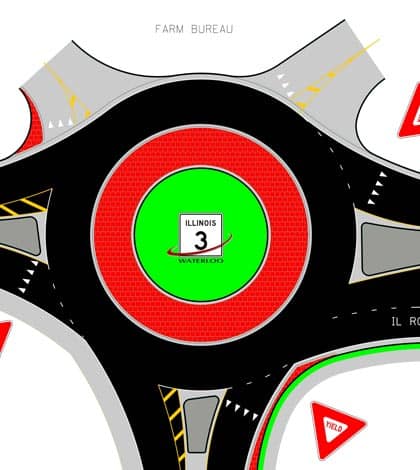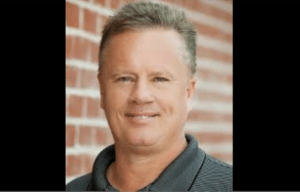IDOT explains local roundabout decision

Pictured is an engineering graphic of the proposed roundabout to be constructed on Route 156 at Lakeview Drive just west of Route 3 in Waterloo. (courtesy of IDOT)
A new roundabout being constructed on Route 156 at Lakeview Drive just west of Route 3 in Waterloo has scarcely escaped the notice of motorists in the community over recent weeks.
And just about everyone has an opinion on it.
Comments on a Republic-Times Facebook post last week regarding the impending roundabout have ranged from the tame — “Dislike” — to the virtually unprintable.
A host of concerns have been expressed in the upwards of 50 comments. But a look back at the history of the project sheds light not only on the decision to install the roundabout rather than pursuing other traffic mitigation options, but also on the opportunities residents had to share their thoughts throughout the planning process.
“A Community Advisory Group was an intricate part of the preliminary design process,” said Karen Geldert, senior project studies engineer with IDOT. “This project’s CAG was made up of residents of Waterloo, farmers in the Waterloo area, commuters (and) city officials, among others.
“Because of the farmers’ input on the CAG, it was brought to the design team’s attention that farm equipment had to be accounted for in the roundabout design. Therefore, the roundabout has been designed to accommodate farm equipment,” Geldert added.
When the roundabout was introduced as part of the larger Route 3 improvement project six years ago, a series of public hearings, complete with videos and roundabout simulators, were held for affected and interested drivers alike.
Through these meetings, which took place in September 2011 and February 2012, engineers were on hand to answer questions, address specific concerns and provide simulations.
The final design was formally approved in 2012 and has been available on the IDOT website at www.idot.illinois.gov/projects/il-3-project ever since.
It can be human nature to fear the unfamiliar, but those who work with roundabouts promise the devices — unlike stoplights — will keep traffic moving at a steady pace.
“The roundabout, by design, will have less ‘conflict points,’ or points where traffic could have potential conflicts…” Geldert explained. “Moreover, the traffic entering and exiting the roundabout will be doing so at a constant, albeit slower, speed. This will help minimize the wait time and potential of the traffic backing up on Route 3 and on Lakeview Drive, as well as minimizing the possibility of higher speed crashes.”
This reduced wait time also makes roundabouts more attractive to the Environmental Protection Agency, which monitors vehicle emissions and has a hand in making decisions regarding the installation and cycle time of every stoplight located on a state highway.
Another benefit of roundabouts is that they can handle greater numbers of traffic over a traditional signaled intersection because at no point do the vehicles within the roundabout come to complete stops, nor do drivers make left turns. This will come in handy during Monroe County Fair week — something roundabout detractors in the area are already dreading, some 50 weeks out.
Another concern is that it will be a magnet for crashes as local drivers try to navigate unfamiliar territory.
But statistics show that crashes in roundabouts are less frequent, and less severe, due to the elimination of left turns and the steady but slower speed vehicles are traveling.
Concerned drivers have also wondered why the roundabout is being constructed so close to an existing stoplight — at Route 3 and Route 156.
In fact, Facebook commenter Dale Ritzel, Ph.D., a native of Valmeyer who has spent his career “teaching people of all ages to be safe and efficient drivers” across the U.S. and western Europe — including on heavy machinery and farm equipment — described the benefits he’s seen from roundabouts. But even Ritzel expressed mild concerns about the roundabout’s proximity to the nearby stoplight.
“It is very close to the traffic signal at Routes 3 and 156. From my experience, the biggest issue will be people going east on Route 156 and the backup of traffic at the traffic signal at the intersection of 3 and 156. I am sure that IDOT has completed the necessary traffic counts and surveys to make sure that backups are only a minimum,” Ritzel wrote.
Geldert concedes the proximity of Monroe County’s first roundabout to a lighted intersection is unique — but that doesn’t mean it won’t work.
“I don’t recall if there are any situations quite like this one, where the roundabout was closely placed to traffic signals. There may be one or two in the state,” Geldert said. “But, the study team did enough investigation, and ran the simulation with the traffic signal and roundabout working in tandem, and it produced favorable results.
“There were five or six options investigated, including signals, stop signs, and the like. All failed under simulation. The only one that did not fail in simulation was the roundabout, and it was above average in efficiency, if not better…” Geldert said.
“Once the (local) community advisory group was presented this by the study team, there was little opposition, if any,” Geldert added.
The proof of the efficacy and ease of use of the Monroe County roundabout won’t emerge fully until it is completed later this year and the rubber hits the road for local drivers.
One thing is for sure, though. It is happening.
And it just might be the perfect solution to a problematic intersection.
As one Facebook commentator wrote, “Roundabouts are fun! (It) breaks up the monotony and prepares you for that trip to Europe you are planning for.”
The entire Route 3 improvement project, including the roundabout, is funded entirely through state funds authorized by former Gov. Pat Quinn and is slated to be completed by the end of 2016.






